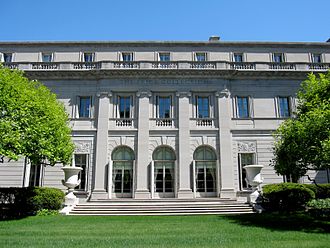Frick Museum
 |
|
| Established | 1935 |
|---|---|
| Location | 1 East 70th Street Manhattan, New York City |
| Coordinates | 40°46′16″N 73°58′02″W / 40.7712°N 73.9673°WCoordinates: 40°46′16″N 73°58′02″W / 40.7712°N 73.9673°W |
| Type | Art |
| Director | Ian Wardropper |
| Public transit access |
Subways: Buses: M1, M2, M3, M4, M66, M72, M98, M101, M102, M103 |
| Website | http://www.frick.org |
The Frick Collection is an art museum located in the Henry Clay Frick House on the Upper East Side in Manhattan, New York City at 1 East 70th Street, at the northeast corner with Fifth Avenue. It houses the collection of industrialist Henry Clay Frick (1849–1919).
Henry Frick started his substantial art collection as soon as he started amassing his fortunes. A considerable amount of his art collection is located in his former residence "Clayton" in Pittsburgh, which is today a part of the Frick Art & Historical Center. Another part was given by his daughter and heiress Helen to the Frick Fine Arts Building, which is on the campus of the University of Pittsburgh.
The family did not permanently move from Pittsburgh to New York until 1905. Henry Frick initially leased the Vanderbilt house at 640 Fifth Avenue, to which he moved a substantial amount of his collection. He had his permanent residence built between 1912 and 1914 by Thomas Hastings of Carrère and Hastings. He stayed in the house until his death in 1919. He willed the house and all of its contents, including art, furniture, and decorative objects, as a public museum. His widow Adelaide Howard Childs Frick, however, retained the right of residence and continued living in the mansion with her daughter Helen. After Adelaide Frick died in 1931, the conversion of the house into a public museum started.
John Russell Pope altered and enlarged the building in the early 1930s to adapt it to use as a public institution. It opened to the public on December 16, 1935. Various additions to the architecture and landscape architecture of the museum site have been considered over the years including the placement of a prominent magnolia garden from the 1930s. As stated by the museum announcements: "As a result of a decision of the Board of Trustees in 1939, three magnolias were selected for the Fifth Avenue garden. The two trees on the lower tier are Saucer Magnolias (Magnolia soulangeana) and the species on the upper tier by the flagpole is a Star Magnolia (Magnolia stellata)."
...
Wikipedia

